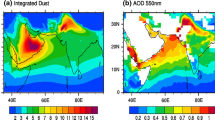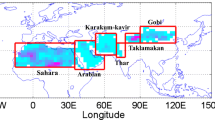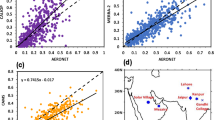Abstract
The paper addresses influence of dust particles on the aerosol loading over the major deserts in the northern hemisphere. The role of dust aerosols in the total aerosol concentration and size distribution of the particles are analysed. It is observed that the aerosol loading is high in the northern hemisphere of which the deserts and adjoining areas in Asia and Africa play a leading role. Over the entire oceanic region, except some parts of the Atlantic Ocean near to the West coast of Africa and the Arabian Sea, aerosol loading is less. The Sahara Desert is the prominent source of dust aerosols throughout the year. The deserts of Asia are also prominent sources of dust aerosols on a global basis. Above 70% of the total aerosol optical depth (AOD) is contributed by the dust particles, reaching to around 90% during spring months March, April and May over the Sahara Desert, which is the major source of dust aerosols. Goddard Chemistry Aerosol Radiation and Transport model is used to estimate the dust aerosol concentration over the deserts of Asia and Africa. The model output almost agrees with the regions of dust loading obtained from the Envisat/SCIAMACHY. Hence, the model is reliable in estimating the dust aerosol loading over the major dust aerosol sources. The major portion of the total dust loading belongs to coarse mode particles.





Similar content being viewed by others
References
Bovensmann H, Burrows JP, Buchwitz M, Frerick J, Noel S, Rozanov VV (1999) SCIAMACHY: mission objectives and measurement modes. J AtmosSci 5:127–150
Brunekreef B, Holgate ST (2002) Air pollution and health. Lancet 360:1233–1242. https://doi.org/10.1016/S0140-6736(02)11274-8
Carlson TN, Benjamin SG (1980) Radiative heating rates for Saharan dust. J AtmosSci 37:193–213
Chin M, Ginoux P, Kinne S, Torres M, Holben BM, Duncan BN, Martin RV, Logan JA, Higurashi A, Nakajima T (2002) Tropospheric aerosol optical thickness from the GOCART model and comparisons with satellite and sun photometer measurements. J Atmos Sci 59:461–483
Christopher SA, Jones TA (2010) Satellite and surface-based remote sensing of Saharan dust aerosols. Remote Sens Environ 114:1002–1007
Creamean JM, Spackman JR, Davis SM, White AB (2014) Climatology of long-range transported Asian dust along the west coast of the United States. J Geophys Res-Atmos 119(21):12171–12185
Creamean JM, Suski KJ, Rosenfeld D, Cazorla A, DeMott PA, Sullivan RC, White AB, Ralph FM, Minnis P, Comstock JM, Tomlinson JM, Prather KA (2013) Dust and biological aerosols from the Sahara and Asia influence precipitation in the western US. Science 339:1572–1578
DeMott P, Sassen K, Poellot M, Baumgardner D, Rogers D, Brooks S, Prenni A, Kreidenweis S (2003) African dust aerosols as atmospheric ice nuclei. Geophys Res Lett 30: 1732.doi: 17https://doi.org/10.1029/2003GL017410
Diner DJ, Beckert JC, Hothwell GW, Rodriguez JI (2002) Performance of the MISR instrument during its first 20 months in Earth orbit. IEEE Trans Geosci Remote Sens 40:1449–1466
Duce RA (1995) Sources, distributions and fluxes of mineral aerosols and their relationship to climate. In: Charlson RJ, Heintzenberg J (eds) Dalhern Workshop on aerosol forcing of climate. John Wiley, New York, pp 43–72
Grousset FE, Ginoux P, Bory A, Biscaye PE (2003) Case study of a Chinese dust plume reaching the French Alps. Geophys Res Lett 30: 1277.doi: 12https://doi.org/10.1029/2002/gl016833
Hallar AG, Petersen R, Andrews E, Michalsky J, McCubbin IB, Ogren JA (2015) Contributions of dust and biomass burning to aerosols at a Colorado mountain-top site. Atmos Chem Phys 15:13665–13679
Huang J, Guo J, Wang F, Liu Z, Jeong M, Yu H, Zhang Z (2015) Calipso inferred most probable heights of global dust and smoke layers. J Geophys Res-Atmos 120:5085–5100
Kok JF, Parteli EJR, Michaels TI, Karam DB (2012) The physics of wind-blown sand and dust. Rep Prog Phys 75:106901. https://doi.org/10.1088/0034-4885/75/10/106901
Lambert F, Delmonte B, Petit JR, Bigler M, Kaufmann PR, Hutterli MA, Stocker TF, Ruth U, Steffensen JP, Maggi V (2008) Dust -climate couplings over the past 800,000 years from the EPICA Dome C ice core. Nature 452(3):616–619
Levin Z, Ganor E, Gladstein V (1996) The effects of desert particles coated with sulfate on rain formation in the eastern Mediterranean. J Appl Meteorol 35:1511–1523
Li F, Vogelman A, Ramanathan V (2004) Saharan dust aerosol radiative forcing measured from space. J Clim 17:2558–2571
Mahowald N, Kiehl L (2003) Mineral aerosol and cloud interactions. Geophys Res Lett 30:1475. https://doi.org/10.1029/2002GL016762
Prospero J, Lamb P (2003) African droughts and dust transport to the Caribbean: climate change implications. Science 302:1024–1027
Prospero JM (1996a) Saharan dust transport over the North Atlantic Ocean and Mediterranean: an overview. In: Guerzoni S, Chester R (eds) The impact of desert dust across the Mediterranean. Kluwer Academic Publishers, Dordrecht, pp 133–151
Prospero JM (1996b) The atmospheric transport of particles to the ocean, in particle flux in the ocean. In: Ittekkot V, Schaffer P, Honjo S, Depetris PJ (eds). John Wiley & Sons Ltd, Chichester
Ryder CL, Highwood EJ, Lai TM, Sodeman H, Masham JH (2013) Impact of atmospheric transport on the evolution of microphysical and optical properties of Saharan dust. Geophys Res Lett 40:2433–2438
Satheesh SK, Moorthy KK (2005) Radiative effects of natural aerosols: a review. Atmos Environ 39(11):2089–2110
Satheesh SK, Srinivasan J (2002) Enhanced aerosol optical depths over the Arabian Sea during pre-monsoon season. Geophys Res Lett 29(18):1874. 10, 1029/2002GL015687
Seinfeld JH, Pandis SN (1998) Atmospheric chemistry and physics: from air pollution to climate change. John Wiley & Sons Inc, New York
Shao Y (2008) Physics and modelling of wind erosion, 2nd edn. Springer, Heidelberg
Sivaprasad P, Babu CA (2012) Role of sea surface wind and transport on enhanced aerosol optical depth observed over Arabian Sea. Int J Remote Sens 33:5105–5118
Tegen I, Hollrig P, Chin I, Fung I, Jacob D, Penner J (1997) Contribution of different aerosol species to the global aerosol extinction optical thickness: estimates from model results. J Geophys Res 102:23895–23915
Tegen I, Lacis AA (1996) Modeling of particle size distribution and its influence on the radiative properties of mineral dust aerosol. J Geophys Res 101(D14):19237–19244
Wolff EW, Chappellaz J, Blunier T, Rasmussen SO, Svensson A (2010) Millennial-scale variability during the last glacial: the ice core record. Quat Sci Rev 29(21–22):2828–2838
Acknowledgements
The first author is thankful to the University Grants Commission, India, for providing fellowship during the period of study, and the second author acknowledges the financial support received from the ISRO in the form of RESPOND Project (No. 2/341) for carrying out the analysis. The authors acknowledge Geovanni for providing analysis and visualisation tool.
Author information
Authors and Affiliations
Corresponding author
Rights and permissions
About this article
Cite this article
Sivaprasad, P., Babu, C.A., Samah, A.A. et al. An analysis on the dust aerosol climatology over the major dust sources in the northern hemisphere. Arab J Geosci 10, 422 (2017). https://doi.org/10.1007/s12517-017-3191-x
Received:
Accepted:
Published:
DOI: https://doi.org/10.1007/s12517-017-3191-x




